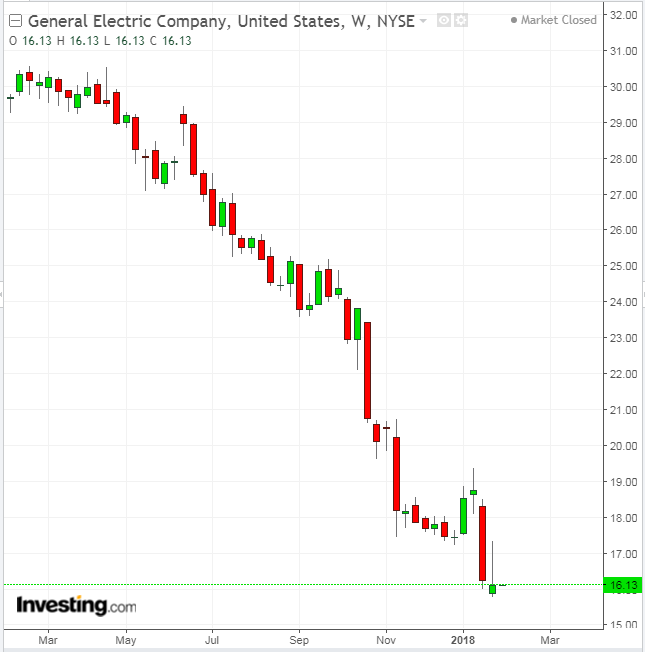When you consider the recent performance of General Electric (NYSE:GE), one of the world’s largest infrastructure and technology conglomerates, there's nothing to cheer about. GE was the worst performing stock on the Dow Jones Industrial Average last year, tumbling about 45% in 2017.

And 2018 doesn’t look promising. The company's share price continues to plunge. For millions of GE investors this unraveling of what was once a solid and reliable stock has been very painful.
Indeed, GE is one of America's most widely held stocks. Retirees and retail investors have counted on what were once generous dividend payments from this 125-year-old iconic name which produces bulbs, appliances, and jet engines for global consumers.
But General Electric is in the midst of a massive change after demand for its key revenue-producing products, such as power plants and locomotives weakened, and cash began to dry up. About $125 billion in market value has vanished from GE since November 2016, as its CEO Jeff Immelt left, leaving behind a mess of extreme magnitude.
The biggest shock for income investors came when the company’s new CEO, John Flannery, decided this past November to cut its rock-solid dividend in half. It was only the second time since the Great Depression that GE has cut its dividend. While slashing the payout, Flannery acknowledged that fixing GE will take time and require a great deal of business restructuring.
But GE’s troubles didn’t end there. This month GE disclosed that it was subject to two investigations by the U.S. Securities and Exchange Commission for a $6.2 billion charge related to an old insurance business and the accounting procedures at its ailing power equipment unit.
What’s Next for GE?
Many investors, who look for bargains with a long-term investment horizon, are asking this fundamental question: does GE stock at its multi-year low offer a bargain, and whether they should bet on this shrinking conglomerate's turnaround?
Just to keep things in perspective, this is not the first time GE has faced such a bleak outlook. Its stock plummeted to under $9 per share after the 2008 financial crisis after its consumer finance business suffered massive losses. This forced the company to announce its first-ever dividend cut, raise $12 billion in a stock offering and an additional $3 billion from the world’s most successful value investor, Warren Buffett.
During the following eight years, GE stabilized its revenue and net income. Its stock price surged to more than $31 before this recent downturn started in late 2016.
Here is what GE intends to achieve as part of its latest turnaround plan:
- By cutting the yearly dividend in half to $0.48 a share, GE expects to save more than $4 billion a year.
- The company aims to sell $20 billion worth of its businesses in the next couple of years, including the transportation division and the light bulb business which has been a symbol of the brand and the company for 125 years.
- By selling these legacy businesses, GE's mission is to become a modern industrial company that sells things like jet engines, power plants and MRI machines.
- GE has also cut its workforce, which totaled about 295,000 at the end of 2016. GE recently told investors that its corporate headcount will be 25% smaller in 2018.
Is GE Stock a Buy?
Trading at $16.13, GE stock has lost almost half of its value during the past 12 months. There is no doubt that this will be a dead investment for at least the next six months, or maybe even a year, but I think GE is a good turnaround bet for long-term investors.
Investing in turnaround stocks is a high-risk but a high-reward strategy. If you do your homework well, you might see returns in the triple digits. Turnarounds can be described as the ultimate contrarian play, since you’re betting on a company other investors don’t believe in.
In most cases, turnarounds tend to involve bankrupt companies that need to sell their profit-making divisions or companies that need to spin off unprofitable divisions.
This is exactly where GE is today. It’s restructuring at a time when the U.S. and the global economy in general are in much better shape than where they were during the last Great Recession. Which means that GE will be able to fetch much better prices for any assets it plans to sell.
I think GE’s current price is already reflecting most of the negative developments. And the move from here is likely to be higher. It’s a good contrarian bet if you have the stomach for taking higher risk.
